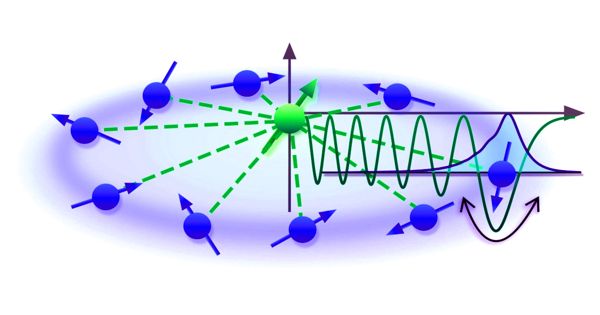A significant breakthrough in the field of spintronics, researchers in the U.S. The Department of Energy (DOE) Brookhaven National Laboratory and Yale University have shown the ability to regulate spin dynamics in magnetic materials by modifying their thickness. The research, published today in Nature Materials, could lead to smaller, more energy-efficient electronic devices.
“Instead of looking for different materials that share the right frequencies, we can now change the thickness of a single material – iron, in this case – to find a magnetic medium that will allow the transfer of information across the device,” said Brookhaven physicist and main investigator Valentina Bisogni.
Researchers discovered the thickness of magnetic materials can act as a “knob” for fine-tuning spin dynamics, a key property for developing next-generation electronics.
Traditional electronics depend on the fundamental property of electrons for the transmission of information. However, when electrical current flows across the system, it dissipates heat, restricting how small devices can be built without the risk of overheating and losing efficiency. In order to satisfy the need for smaller and more sophisticated electronics, researchers are looking at an alternative solution based on a particular fundamental electron-spin property. Similar to charging, the spin will travel through a substance like a current.
The distinction is that the charge current consists of electrons that travel physically, while in a spin “current,” the electrons do not move; however, they give off their spin path to each other like passing a baton in a relay race – one that has a long line of “runners” that never really drive.
“There is always a need for more memory or storage capacity in electronic devices, and heat dissipation is currently impeding us from creating devices on a smaller scale,” Bisogni said. “Relying on spin instead of charge significantly reduces overheating in devices, so the goal of spintronics is to realize the same device functionalities, or better, that is already known in traditional electronics–without the drawbacks.”

To date, spin dynamics has usually been calculated using neutron scattering techniques; however, this approach allows samples to be analyzed in bulk (multiple grams of a sample at once). In real-world implementations, the material needs to be scaled down to even smaller sizes.
“It is very difficult to predict how certain materials will perform in different length scales,” Bisogni said. “In view of the fact that many electronic devices consist of a very small amount of material, it is important to study how the properties in the thin film are compared to the bulk.”
To address this scientific problem, the research team used a technique called resonant inelastic x-ray scattering (RIXS) to analyze thin iron films as thin as one nanometer. Although RIXS is well known in the scientific community, this work is just one of a few examples where researchers used this technique to study spin dynamics in such thin material. Advanced capabilities of the Soft Inelastic X-ray Scattering (SIX) beamline at the National Synchrotron Light Source II (NSLS-II) – DOE Office of the Research Consumer Facility at the Brookhaven National Laboratory have made this possible.
“We were able to perform these measurements by combining the ultrabright x-ray source at NSLS-II with the unparalleled energy resolution and spectrometer at the SIX beamlines,” said Jonathan Pelliciari, lead author of the study and a scientist at SIX.
The SIX beamlines is fitted with a 50-foot spectrometer arm, located in its own building adjacent to the NSLS-II experimental floor. This long, movable arm enables SIX to reach an exceptionally high energy resolution and to expose the mutual motion of electrons and their rotation within the substance.
The research team first analyzed iron in bulk and validated the findings of previous neutron dispersion techniques. Then, as they progressed into thinner materials, not only did they effectively detect spin dynamics at the atomic scale, but also discovered thickness could act as a “knob” for fine-tuning and manipulating spin dynamics.
“It was exciting to see how iron maintained its ferromagnetic properties from the bulk to just a few monolayers,” said Bisogni, SIX’s lead beamline scientist. “With iron being such an elementary and simple material, we consider this to be a benchmark case for studying the evolution of properties as a function of thickness using RIXS.”
“This work is the result of a strong synergy between world-class facilities,” Pelliciari said. In addition to the high-level NSLS-II experiment and characterization analysis, this project would not have been feasible without the knowledge and state-of-the-art synthesis capabilities of our colleagues at Yale University.”
“Because Yale is only two hours away from NSLS-II, I was able to participate fully in the experiment,” said Sangjae Lee, a graduate student at the Charles Ahn Lab at Yale University. Lee and Ahn are co-authors of this report. “This experiment was an inspiring opportunity to perform hand-on synchrotron measurements with world-class NSLS-II scientists.”
Researchers at Brookhaven’s Department of Condensed Matter Physics and Materials Science have offered analytical support for the best understanding of experimental results.
The research team at SIX will continue to use RIXS to observe the material properties of spintronics. Their ultimate aim is to create a “on or off switch” to control spin dynamics in devices and to understand the underlying microscopic mechanism.















